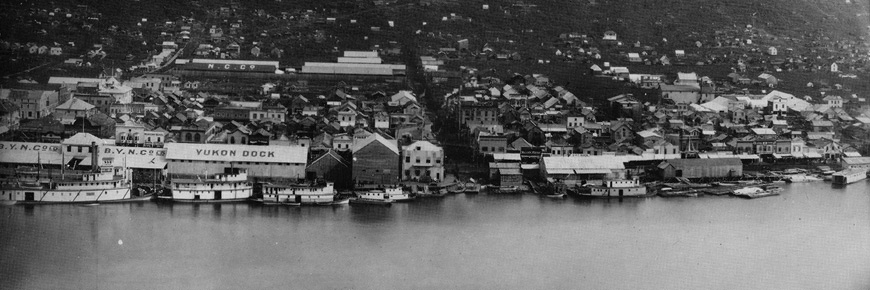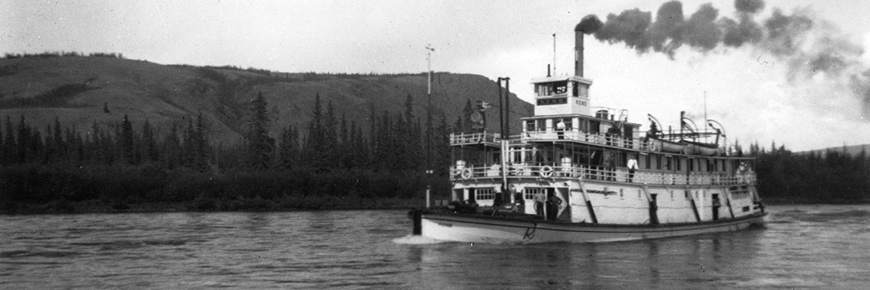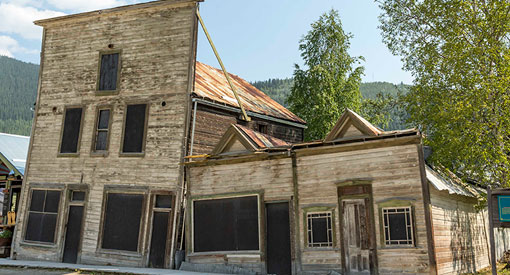
© Parks Canada / Hutchings Collection #180
S.S. Keno National Historic Site
Klondike National Historic Sites
Reasons for national historic significance
The S.S. Keno was part of the fleet that played a major part in the history of the Yukon Territory. Without the riverboats, the gold of the Klondike and the silver, lead, and zinc of the Mayo district would have remained in the hills for at least another half century, and the development of the Canadian West and North would have suffered in consequence. The S.S. Keno is an example of the riverboats used on the lakes and rivers of the Yukon and displays the design and application of steam powered sternwheeler technology.
Background

In 1869, the Alaska Commercial Company put the first sternwheeler on the lower Yukon River to supply the trading posts from St Michaels on the Bering Sea to Fort Selkirk.
By the time of the Klondike Gold Rush, several companies had established trading posts and sternwheelers and a basic transportation system was in place.
Sternwheelers were the only practical craft for the Yukon River. The S.S. Keno, which was built in 1922, had a shallow two-foot draft. This allowed it to navigate through shallow water and sections with ever-changing and treacherous sandbars. It had a narrow beam to be able to make turns around tight, narrow curves. The stern-mounted paddle wheel permitted the sternwheeler to land virtually anywhere along riverbanks and it assisted in getting off sandbars. It was protected from snags and sweepers by the hull. The sternwheelers burned wood to provide steam for their power and all along the river wood camps sprang up to supply the fuel.
The S.S. Keno worked mainly on the Stewart River hauling silver lead concentrate from Mayo to Stewart City. It was also used for the early and late season trips to Dawson City.
The seasonal nature of steamboat operations (three to four months in the summer), along with the development of roads, inevitably meant the end of the steamboat era. By 1955, the remaining sternwheelers were dry-docked for the last time.
The sternwheelers, and the transportation companies which ran them, played an important role in the economic development of the Yukon. They brought in all the supplies required by the Klondike's booming population and in subsequent years supplied all of the heavy machinery, which were essential for the success of industrial, corporate mining. The sternwheelers also made the development of new areas possible and led to the creation of new mines in places such as Mayo.
The sternwheelers were more than a carrier of men and supplies into and out of the territory. They supported a timber industry, contributed to the development and evolution of mining and united the small communities that hugged the riverbank.
Steamer operations

Prior to the Klondike Gold Rush there were only a handful of steam powered sternwheelers working on the Yukon River. So quickly did word of the wealth of the Klondike affect the outside world that 57 registered steamboats, carrying more than 12,000 tons (10,886 t) of supplies, docked at Dawson City between June and September of 1898. A year later, 60 sternwheelers, 8 tugs and 20 barges were in service on the river.
An important new industry was created along the river to service the steamers. Wood camps were established along the waterway to feed the wood-fired boilers, their contracts running into the thousands of dollars annually, employing large numbers of men. A steamer, depending upon its size, consumed approximately 120 cords of 4 foot (1.2 m) wood every trip from Whitehorse to Dawson City.
Barges were pushed ahead of the steamers to handle the tonnage. Freight was as varied as only a gold rich country could demand: mining equipment, horse and dog feed, flour and dynamite was packed beside cut crystal, fine linens, canned oysters, evening gowns and first editions.
The officers who commanded these ships were a special breed, many former Mississippi River men or deep-sea captains. Resourceful and self-reliant, the officers were in constant combat with a river, which could hide snags, rocks, sandbars, rapids or could suddenly fill with ice floes to crush the light wooden hulls.
Milestones
1869
Sternwheelers began supplying the fur traders and prospectors on the lower Yukon River.
1898
By 1898, 57 steamboats owned by a number of companies carried tons of supplies to the goldfields of the Klondike.
1900
The White Pass and Yukon Railway was completed from Skagway to Whitehorse thus opening up the Upper Yukon River route.
1914
All sternwheelers on the upper Yukon River are owned by one company.
1922
The S.S. Keno was built to transport silver lead concentrate from the Mayo district to Stewart City.
1944
Alaska Highway completed
1953
Klondike Highway completed
1955
The last sternwheeler was dry-docked in Whitehorse.
1960
The S.S. Keno was moved to her present berth on Dawson's waterfront.
1962
Parks Canada refurbished the vessel and declared it a National Historic Site on July 1st.
National Historic Site designation

Unfortunately none of the steamers in service at the time of the gold rush have survived. The National and Historic Sites Branch has preserved a typical vessel dating from 1922, the Steamer Keno built in Whitehorse. The Keno was in good condition, necessitating little restoration work.
Built to transport silver, lead and zinc ore from the mines in the Mayo district 180 miles (290 km) to Stewart City, the Keno is 130 feet (40m) long. The ore was stock-piled on the bank of the river at Mayo Landing all winter, awaiting the arrival of the Keno in mid-May. In 1938 over 9,000 tons (8,165 t) of ore were carried by the Keno, every sack of it man-handled.
In 1960 the Keno was moved to her present berth, on Dawson's waterfront, beside the Canadian Imperial Bank of Commerce. Her shallow draught and low superstructure made the transfer easier. On her last trip to Dawson, she carried 21 passengers, mostly newspaper correspondents and camera men. The old river steamer has been preserved to commemorate an era now passed forever.
- Date modified :

